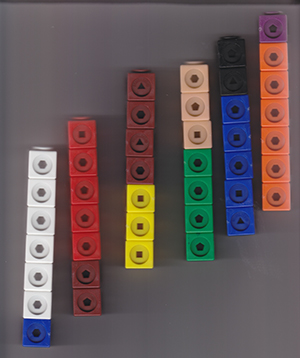Helping students who struggle with math, part 2

By Kathy Kuhl Does your child struggle with math? Last time I discussed how handwriting struggles or attitudes of fear, discouragement, or despair can keep your child or teen from learning math. (Visit that post.)

Today let’s look at three other ways students struggle–and how to help!
3. Develop their Sense of Number
Some children suffer from a poor sense of number. Does your son understand that “four” means this many (****) means “4”? Can your daughter look at three-fourths of a circle and see whether it is more or less than half? If your student divides 100 by 8 and gets 125, does he say, “Wait. I started with 100 and divided it into 8 groups. The quotient’s got to be less than 100!”?
How do you help a child strengthen their number sense?
- Let them play with pouring water (or sand in a sandbox) and with grouping similar small objects to learn to recognize differences in quantity.
- Teach them to subitize: to rapidly, accurately recognize how many objects are in a small group without counting. Games with dice and double six dominos can help a student learn to recognize that two columns of three dots is a six, and so on.

How many ways can you make a seven? These Multifix cubes make it easy to show without writing. - Play games like Tiny Polka Dot for younger students and Denise Gaskins’ math games. (Links are below.)
- For place value, build bundles of craft sticks: bunches of tens, ten tens to make a hundred, and ten hundreds to make a thousand. Then build numbers, add, and subtract with them. Also…
- Build numbers with base ten blocks, then add and subtract with them.
- Cut paper plates or tortillas into half circles, one-, two- and three-quarter circles, and one- and two-thirds. Show your child two pieces and ask which is larger. Let them practice finding equivalent fractions, then adding with them.
- When introducing integer arithmetic, have your child step up and down stairs to act out addition: 6 + -2 means go up six, then down two.
- Use algebra tiles or graph paper to help students grasp that x2 is an x-by-x sized square, while x is a line (or on paper tiles, a thin row).
4. Language-based Learning Disabilities
When children or teens struggle with language, it can cause them to struggle with math, making it difficult to comprehend a new procedure. Dyslexia or some other language-based learning disability can keep a student from determining what calculation is needed. Deciding which procedure to follow for a particular problem also can be harder.
How to help:
- Teach the language of mathematics slowly and explicitly.
- Note discrepancies of language. We have tenths and fourths, but not two-ths or three-ths.
- Use large print.
- Incorporate hand motions. For instance, to teach commutativity, when I say “2 + 6 = 6 + 2,” I hold out two fists in front of me, representing the numbers. As I say the second half, I cross my arms so that what was on the left is now on the right. I repeat with many examples, and make children imitate me.
- Use mnemonics. Google “math mnemonics” for ideas.
- For word problems, teach and have the children highlight words that correspond to math operations. “Six people were in the car and two got out—that’s subtraction.”
- Have children act out many simple examples of one kind of word problem with toys to strengthen understanding.
- Children should make their own personal math manuals. Whenever they grasp a new process, like long division, addition of fractions, or one kind of word problem, they should write the steps in their own words, with examples. (If writing is hard, have them just write the examples, and dictate their process for you to transcribe.)
- Teach new procedures and concepts with simple computations.
- Practice your examples before teaching to make sure you haven’t added unnecessary complexity.
- Sometimes focus practice on just one step of a difficult procedure.
- Use colored markers and pencils to highlight key elements.
5. Memory and Math Facts
- Use triangle flash cards to teach multiplication fact families, e.g. 3 x 5 = 15, 5 x 3 = 15, 15 ÷ 3 = 5, 15 ÷ 5 = 3 can all be taught from the 3-5-15 triangle card.
- Let the child build, draw and write examples of concepts. For example, to introduce ¾, the child should build ¾ of a square with pattern blocks and construct ¾ of a circle by placing a 3 quarter circles together, like a pie minus a large slice. Then the children draw what they’ve built (don’t demand perfect accuracy), and label them both with words and numbers, with the fraction bar horizontal and again with it diagonal as in ¾.
- Try teaching skip counting using songs.
- Teach math facts using stories, or let children make up their own. Give each digit its own character: 1 might be a giraffe, 2 a swan, etc.
- Give untimed practice.
- Tape a number line on their desktop, and let their fingers walk up and down to solve problems.
After daily practice of math facts, let the student use a times table or basic calculator functions. Don’t let difficulty with basic arithmetic facts hijack the whole math lesson. I know people with PhDs in math who struggle with basic addition, but who can solve problems on the frontiers of math–problems I cannot begin to explain.
Got problems?
How does your child struggle with math? What questions do you have about how to help them? I could go on all day… but neither of us wants that. So post your questions and comments below, please.
Resources
Check all the math handouts from my workshops. Under the talks tab, choose “Handouts.”
Denise Gaskins’ many books of math games. Here’s one example; another is below.
My favorite math game for preschool-grade 1 level math is Tiny Polka Dot.


